Six tips to write compelling product descriptions that sell
It’s such a common mistake. Even professionals make it sometimes: writing product descriptions that simply describe the products and outline the features.
Why is this the wrong approach? Because features don’t tell a story. They don’t let prospects imagine what it would be like to own that product and how happy, healthy, productive they’d be as a result of using it.
Want to learn how to sell your product in a description? Follow these six tips and you’ll easily create unique, informative, compelling descriptions that will entice prospects into clicking that “buy” button.
1. Focus on your ideal customer
One of the biggest mistakes site owners make with product descriptions is writing copy for anyone who might visit the page in order to get them to buy.
Think about it this way: different people have different reasons for buying a product. So if you’re targeting everyone with your copy instead of targeting your ideal buyer, you’ll end up addressing no one at all.
So the first step to writing product descriptions that sell is to get to know your target customers and understand what would compel them to buy from you.
By knowing who your ideal buyer is, you can write copy that is able to empathise with them and address all their questions and objections.
Just read this description from Think Geek for a unicorn statue:
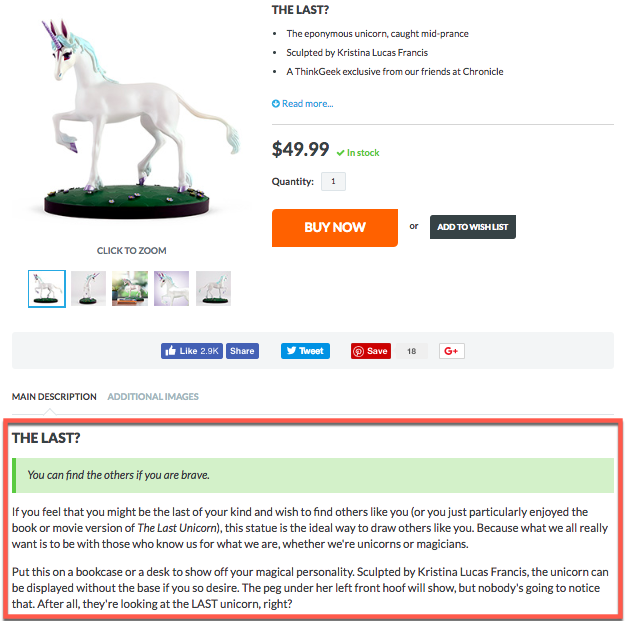
So when writing your product descriptions, always think about your ideal customer. Why would they need or want to buy your product? What questions do they ask that you should answer? What words do they use? What kind of humour or language do they appreciate?
Your product descriptions should be like a conversation you’re having with your ideal customer if they were to enter your physical store. How would you sell it to them if they were standing in front of you? Try to incorporate that language into your copy so you can have a similar conversation online that resonates more deeply with your prospects.
2. Sell the outcome, not the product
You need to stop selling the features and benefits of your product. Instead, look to what happens after the sale – after the customer buys your product.
Why? Because people don’t want to buy products. What they actually want to buy is the outcome or the results they’d achieve once they own and use your product.
For example, people don’t go to the dentist to buy fillings. They go to the dentist to be healthy and pain-free. And people don’t go to a store to buy a drill. They go to a store because they want to make a hole.
The idea is that people are less interested in the products themselves, their features and benefits, and more in what they can achieve or get with them.
So, when writing your product descriptions, think about what your product can do for your prospects. Can it:
- Solve a need, a hassle or a problem?
- Help them achieve a goal or a dream?
- Make them feel happier, healthier, more productive?
- Help them be pain-free?
- Provide them with social status?
Try to determine the desired outcome of your ideal buyer and focus your description on that key message.
Here’s a good example:
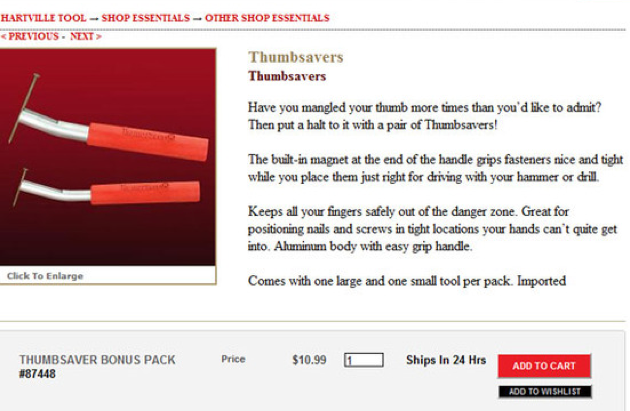
What’s the outcome here? To keep “all your fingers safely out of the danger zone.”
For more helpful tips, we’d recommend reading this fantastic article titled “Drill or hole? What are they buying – and what are you selling?”.
3. Highlight the experience of using the product
You want to know the most effective way to sell a product? Make your prospects imagine they’re already using it.
Research has found that if prospects can hold a product, it increases their desire to own the product. But you’re selling online, which means your prospects can’t touch or hold your products. So what’s the next best thing you can do?
You can appeal to your audience’s imagination through words. Let them picture themselves what it would feel like to touch, feel, own and use your products.
How? Here are a few tricks you can use:
- Start your descriptions using words like “imagine” or “picture yourself”
- Explain how they will feel when they use that product
- Use present and future tenses to tell a story of how they feel now and how they’ll feel, what they’ll achieve or what problems they’ll solve once they use the product
- Describe the outcome and how they’ll feel as a result of using the product
- Use sensory language and words to integrate the five senses into the copy (sight, sound, taste, touch, and smell).
Here’s how ModCloth stirs your imagination with a catchy title and description of a green dress:
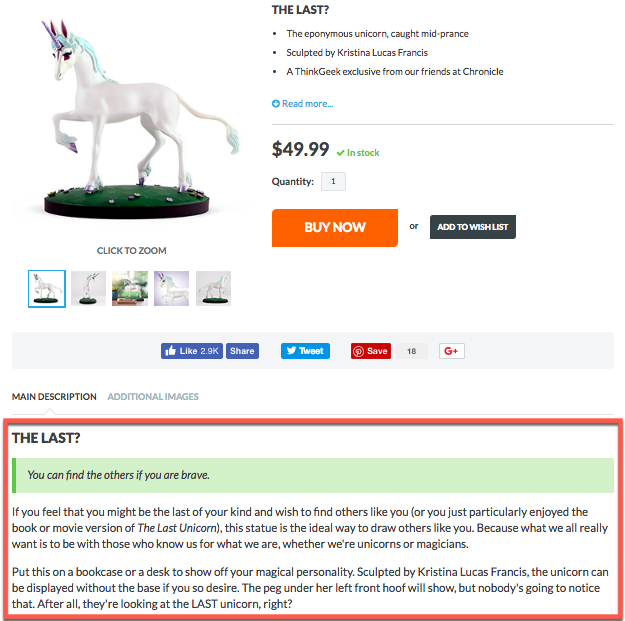
So what you’re doing is you’re telling your audience a story so they can imagine what it would be like to own and use your product.
4.Be specific
Superlatives, clichés and generic descriptions won’t help sell your products. On the contrary, they’ll drive prospects away since your descriptions make your product seem just like any other product out there.
Think your product is amazing, excellent, high quality? Explain what you mean by it. Be specific. Use your customers’ words to get prospects’ attention. Provide proof why this is the case.
Tortuga, for example, not only starts the description with proof, sharing that this backpack has been named “best carry on travel bag” by The Wirecutter, but they also explain why they’ve earned that title.
So what you’re doing is you’re telling your audience a story so they can imagine what it would be like to own and use your product.
4.Be specific
Superlatives, clichés and generic descriptions won’t help sell your products. On the contrary, they’ll drive prospects away since your descriptions make your product seem just like any other product out there.
Think your product is amazing, excellent, high quality? Explain what you mean by it. Be specific. Use your customers’ words to get prospects’ attention. Provide proof why this is the case.
Tortuga, for example, not only starts the description with proof, sharing that this backpack has been named “best carry on travel bag” by The Wirecutter, but they also explain why they’ve earned that title.
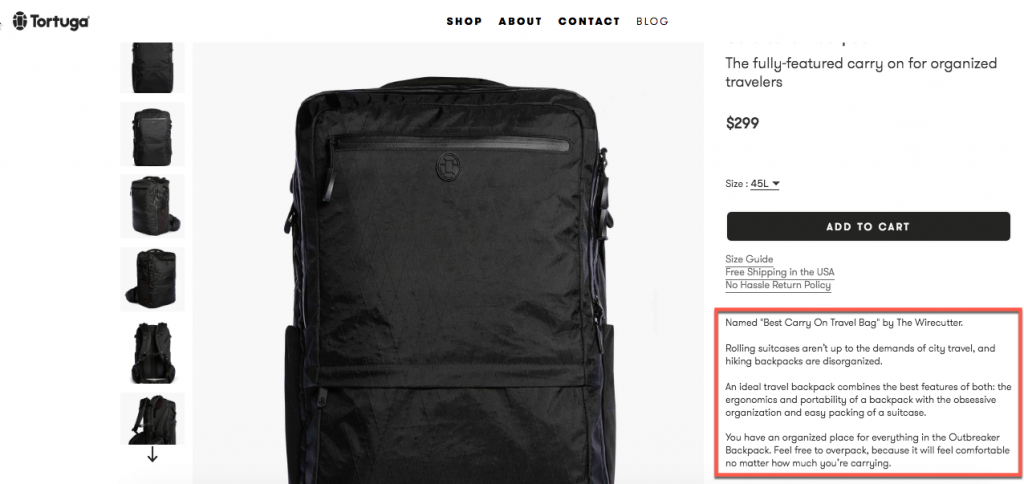
5. Use social proof
People tend to trust and be more likely to purchase products that others have tried before and enjoyed using. This is why social proof is so important, because it gives reassurance to purchasers about buying a product they’ve never used before.
And not only that, but it can also entice users to buy a specific product over another. For example, if you’re looking to buy an iron, you’re more likely to buy the one with the highest number of positive reviews or the one marked as “customers’ favourite” as opposed to one that has no or very few reviews.
Here’s a good example from Mothercare.com:
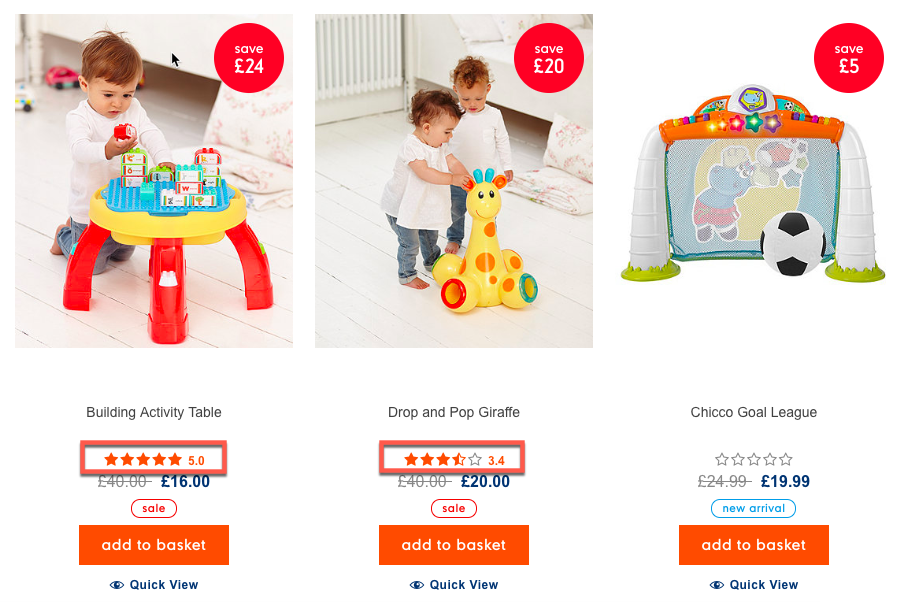
And here’s another fantastic example from Amazon where they organised headphones by category: most gifted, best sellers, hot new releases and most wished for.
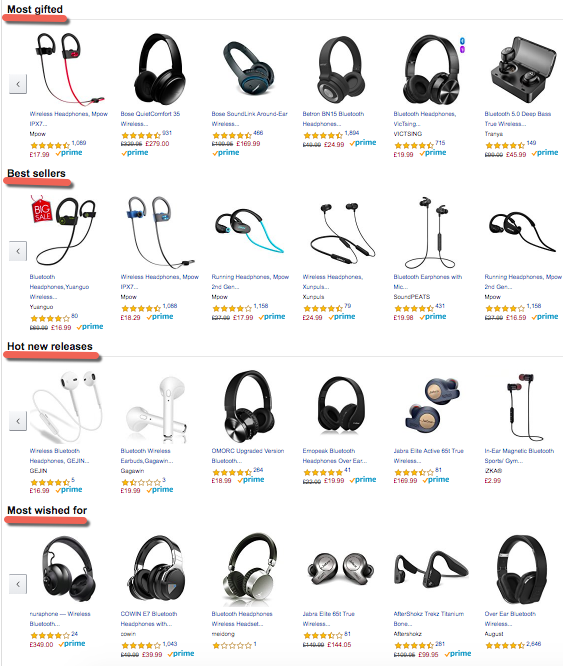
6. Make your description scannable
People don’t read on the web, they scan and skim. That’s why it’s so important to make your descriptions clear and easy to read.
You can easily do this if you ensure every product description on your site includes:
- A visible, enticing headline and subheadings
- Easy-to-scan bullet points
- Plenty of white space
- Short sentences
- Bigger bold fronts for subheads and smaller, regular fonts for paragraph text
ThinkGeek is spot on in their product descriptions format:
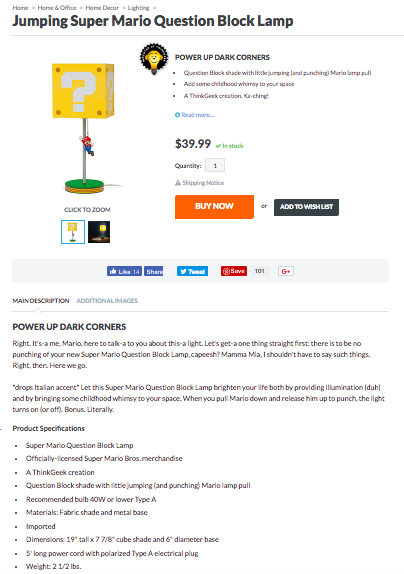
As you can see, the product description includes a heading and subheadings, bullet points and short sentences, making it easy to scan and read.
Wrapping up
Writing a product description should always start with knowing your audience and understanding what their main motives are for buying your product. When you know this well, you can use these six steps to craft descriptions that tell a story, address prospects’ questions and objections, and ultimately sell.
